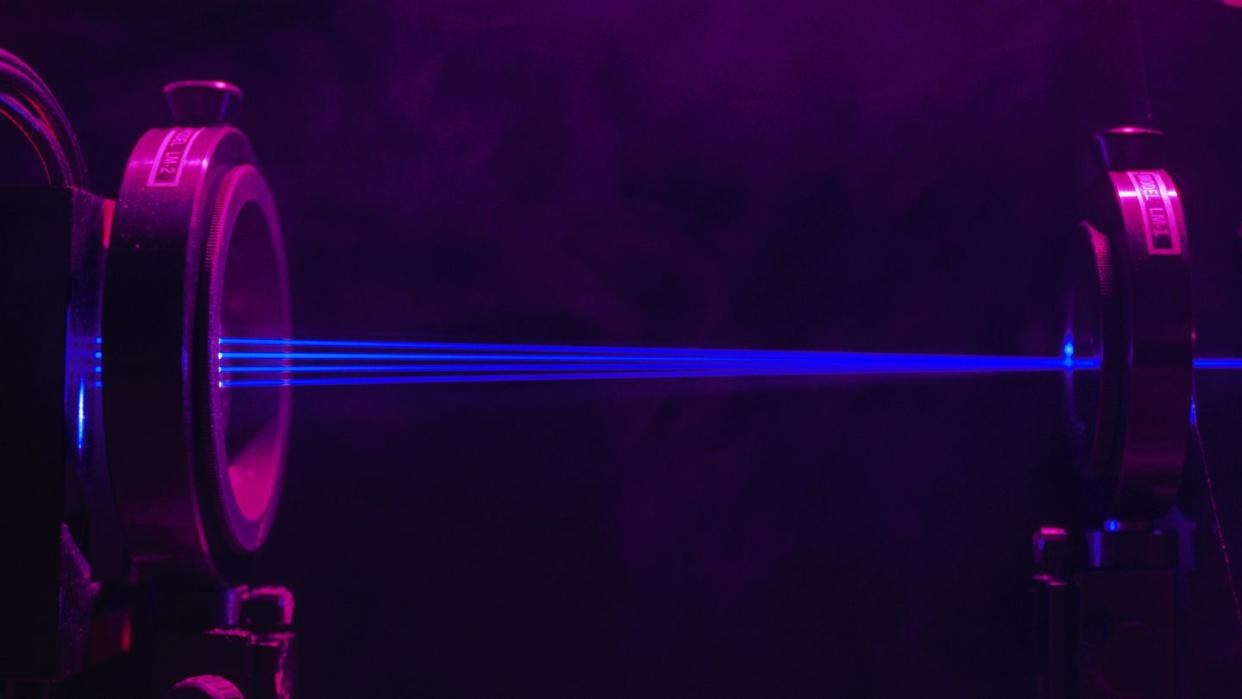The Pentagon Is Trying to Build a Laser That Never Fails

Lasers are a fundamental technology of today’s society, but this amplified light still suffers from shortcomings—extreme temperatures, long distances, or even just fog.
Researchers from the Washington University in St. Louis and Texas A&M University are turning to quantum mechanics to create an “entangled” laser than can overcome these pitfalls.
The research is being conducted via a two-year, $1 million grant from the Defense Advanced Research Projects Agency (DARPA), which can probably think of a few use cases for a quantum laser.
Light Amplification by Stimulated Emission of Radiation, otherwise known as the laser, fundamentally changed human society upon its introduction in the early 1960s. The uses for lasers seem almost endless, and have rearranged how we communicate, perform surgeries, and even pay for groceries. In other words, we very much live in the laser era.
However, this ubiquitous technology isn’t without its shortcomings. Because lasers are essentially just the optical amplifications of light, they’re still subject to failing in adverse conditions—whether that be fog, extreme temperatures, or even just long distances.
Now, scientists at Washington University in St. Louis and Texas A&M University are turning to quantum mechanics to solve these laser-based shortcomings. The research will be conducted thanks to a two-year, $1 million grant from the Defense Advanced Research Projects Agency (DARPA) and will be led by Washington University associate professor Jung-Tsung Shen, who hopes to develop a prototype device called a quantum photonic-dimer laser.
As its name suggests, this device is built around concepts from quantum mechanics. The idea is that two carefully controlled particles of light (a.k.a. photonic dimers) can be used to create a powerful laser beam. The “quantum” part of the equation comes in when these two particles are entangled, which can help protect from some of the deleterious effects lasers can face in challenging environments—when charge is applied to one photon, it directly applies to the other.
“Photons encode information when they travel, but the travel through the atmosphere is very damaging to them,” Shen said in a press statement. “When two photons are bound together, they still suffer the effects of the atmosphere, but they can protect each other so that some phase information can still be preserved.”
As you can probably imagine, entangling two photons isn’t exactly easy, especially since they don’t have a charge. Shen says he instead “glued” two different-colored photons together, which then exhibited the behavior of a blue photon. These entangled photons can then be tweaked to work optimally in fog, extreme temperatures, or any other adverse condition. This would be a huge boon for both communication and imaging, which can be specifically limited by atmosphere and distance.
“Quantum entanglement is a correlation between photons,” Shen said in a press statement. “We are trying to exploit the property of entanglement to do something innovative. The entanglement can do many things that we can only dream of — this is just the tip of the iceberg.”
Researchers around the world are busy applying quantum mechanical properties to classical technologies. Last year, a French research team reported that their “quantum radar”—which similarly uses quantum entanglement techniques—outperformed classical radar by 20 percent. Researchers are also hard at work creating a quantum internet that will one day transmit information in quantum state, which could increase security and improve the study of materials.
So, while the laser was no doubt a world-changing invention, it’s revolutionary introduction may only be the first chapter of its technological journal.
You Might Also Like

